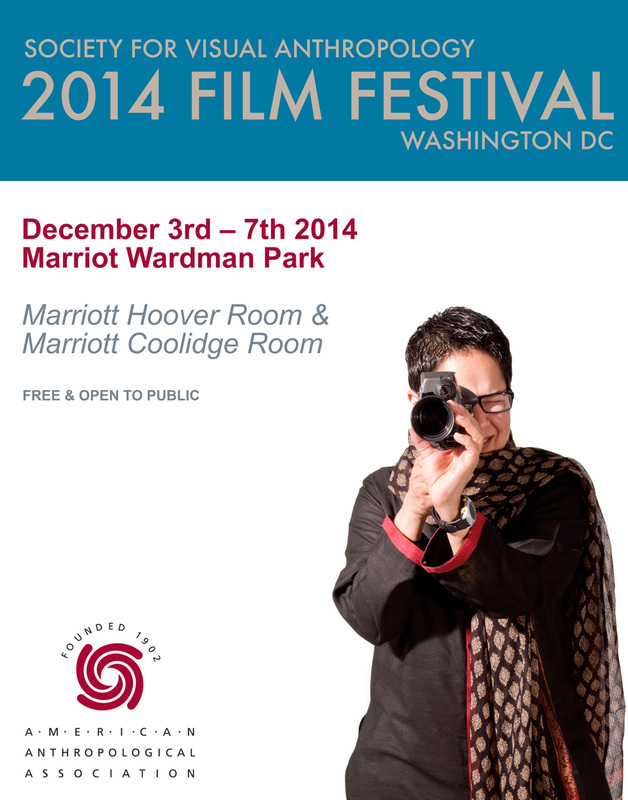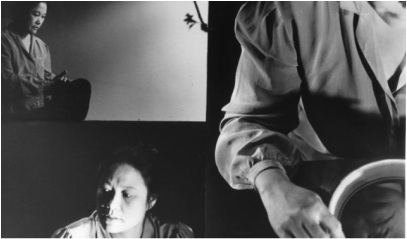|
The 2014 SVA Film and Media Festival program is now online, complete with film abstracts, screening times, locations, and the winning films!
Check out our festival highlights here: 2014 SVA Film and Media Highlights View the entire program online here: 2014 SVA Film and Media Festival Program Or download a handy PDF copy here: 2014 SVAFF Program We kickoff on Wednesday, December 3, 2014 with the Best Feature Film, In the Steppes of Genghis, directed by Mike Majoros. All screenings are open to the public, and I hope to that those attending the AAA Annual Meeting as well as others in the DC area will come watch a few films this December, engage with our filmmakers, and discover new films. http://societyforvisualanthropology.org/2014/11/sva-film-media-festival-special-events-screenings/This year, as Co-Director of the 2014 SVA Film and Media Festival taking place during the AAA Annual Meeting in Washington D.C., I've been working with many others to organize some really exciting special events in addition to our already great film program. The special events include a special anniversary screening of Trinh T. Minh-ha's seminal work, Surname Viet Given Name Nam (1989), followed by a discussion with the filmmaker about feminist perspectives on ethnography and film. I'll moderate the discussion, and I'm really looking forward to bringing this important work back into conversation with anthropologists.
We're also featuring a roundtable discussion on the distribution of ethnographic films, featuring filmmakers, anthropologists, the director of DER (one of the most important distributors of anthropological films), and a specialist on film festivals. And, we've also arranged a screening of the director's cut of The Act of Killing (2012), and the filmmaker Joshua Oppenheimer will be present afterwards for q&a. All this means that the already packed AAA meeting schedule just got more full for all of us -- but I am really pleased to bring these events to DC and to foster more opportunities to think about, and think through, the relationships between film and anthropology. Check out the link above for full session details and descriptions! I'm part of a great panel for this year's American Anthropological Association's Annual Meeting, which is taking place the first week of December in Washington, D.C. This panel focuses on understanding the politics of cultural commodification in China today, with a particular emphasis on the processes through which ethnic minority communities are being reformed as highly valued "resources" within larger state policies and developments. There will be three papers based on research from Yunnan, along with my paper on bull-fighting in Guizhou; details below. If you're planning on attending the meetings from beginning to end, please attend our session. I am really excited to talk about bull-fighting in Guizhou, which is a topic I've been working on for a few years now, and I am looking forward to gaining feedback from other anthropologists.
Session title: Consuming Culture, Reforming Place, and Personifying Value in China Organized by Lara Kusnetzky Wednesday, December 3, 2014 12:00-1:45 My paper: Organized Chaos: Bullfights As Cultural Production and Ethnic Practice in Guizhou Abstract: Bullfights in southeastern Guizhou index Miao cultural vitality and ethnic identity in regional and national tourism campaigns, rural development efforts, and heritage preservation programs. To be clear, while the Chinese phrase for bullfighting is douniu, according to some Miao scholars, bullfighting should be called niudajia to emphasize that two water buffalo fight each other. As events, bullfights are tightly organized competitions, yet often erupt into chaos when the bulls charge their handlers or into the crowds. This paper explores how the organization of bullfights and the enjoyment of them have become ways in which contemporary Miao use local resources, including funds from private entrepreneurs, and local government agencies (such as regional bullfighting associations and cultural bureaus) to assert an ethnic, minority cultural identity within the context, or chaos, of ever-evolving state policies of cultural preservation and rural urbanization. Unlike the many tourism projects in this region, into which bullfighting (or images of) are often incorporated, bullfights remain largely produced for local audiences. By interrogating the politics of bullfights as cultural production and ethnic practice, this paper argues that the shared experience of watching, and enjoying, bullfights reflect and refract contemporary Miao identities in a region and era where distinctive forms of ethnic-ness and cultural-ness are increasingly marketed, promoted, and celebrated. Thus, from their organization, participants, and their ubiquity as video-recordings, bullfights engender what can be called “productive pleasures” and speak to ways in which culture and ethnicity are governed within current state projects to modernize, and urbanize, rural China. One of the coolest things about having my book published is the chance now to discuss and reflect on my work through talks and public lectures. I really enjoyed presenting my work at Emory a few weeks ago to a very engaged audience of faculty, graduate students, and undergraduates. Next week I'll give a public lecture at Hamilton College, in New York, about my research on ethnic tourism in rural China. Since my fieldwork in Upper Jidao and Ping'an villages began eight years ago in 2006, and these lectures are a great chance for me to update my findings and to reconsider some of the implications of what I've observed and analyzed.
Public Lecture The Labor of Leisure: Reconsidering the Work of Tourism in Rural Ethnic China Friday, November 7, 2014 4-6 p.m. Kirmer-Johnson 102 Hamilton College Website: Events Calendar Here |
Archives
April 2024
|

